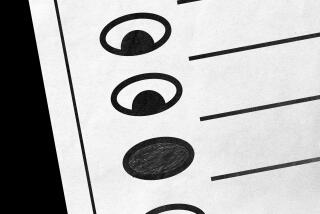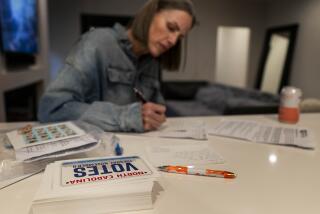Absentee Votes to Play Big Role in Assembly Race : Elections: In anticipation of low turnout, campaign strategists in 10-candidate race aim to bring the poll to their supporters.
When voters go to the polls in April’s special 78th Assembly District primary, the winning margin may already have been decided by thousands of absentee ballots--representing perhaps as much as one-third of overall turnout--political consultants expect to be cast.
“This election could be won or lost before April 10,” said Tom Shepard, a consultant to Democratic candidate Howard Wayne. “What happens before the election is going to be as important as what happens on Election Day.”
Amid predictions that only about 20% of the district’s 193,548 voters will actually cast ballots in the 10-candidate primary, absentee ballots figure prominently in most of the major candidates’ strategies in the race to fill the vacancy created by former Democratic Assemblywoman Lucy Killea’s election to the state Senate last December.
Viewed as an effective method of attracting votes that otherwise might not be cast, absentee ballots also are getting unusually close attention from campaign managers in the 78th District contest because of the pivotal role that they played in recent electoral history--including the race that set the stage for this one.
In last December’s special 39th state Senate District election, which drew national attention as a referendum on abortion and how far Catholic Church leaders may go in opposing it, Killea actually lost among Election Day voters to her Republican opponent, Assemblywoman Carol Bentley. But, having received 5,502 more absentee votes than Bentley--most of which were cast at the peak of the controversy over Catholic Bishop Leo T. Maher’s denial of Communion to Killea because of her pro-choice stand--Killea won by 2,562 votes, 62,283 (51%) to 59,721 (49%).
“We had a couple of aces in the hole!” Killea’s jubilant campaign manager, Craig Reynolds, said on election night. Reynolds’ poker analogy is an apt one, for many political consultants suggest that voters’ growing tendency to cast absentee ballots--a trend accelerated by candidates’ encouragement--has transformed campaigns into a form of seven-card stud, with the absentee ballots being the electoral equivalent of the “down” cards that, when turned over, often alter the outcome.
Traditionally, absentee ballots were used only by voters unable to make it to the polls on Election Day, either because they were out of town or ill. Under those guidelines, absentee totals typically accounted for several percentage points of the overall vote, and usually favored Republicans, who, because they tend to be wealthier than Democrats, are more likely to travel.
In 1978, however, California law was changed to permit people to vote absentee for any reason, including simple convenience. That legislation, said Larry Remer, another of Wayne’s consultants, made absentee voting “the 7-Eleven of politics.”
The potential impact of that change was vividly illustrated four years later, when Republican George Deukmejian’s edge in unusually heavy absentee balloting allowed him to defeat Democrat Tom Bradley in the 1982 gubernatorial election.
Strategic Impact
Though extensive use of absentee ballots figured occasionally in state elections, what piqued political consultants’ interest was absentees’ strategic prominence in the Killea race and two other recent campaigns: Democrat Gary Condit’s win in a special congressional election in the San Joaquin Valley, and Democrat Sal Cannella’s victory in last month’s contest for Condit’s former Assembly seat.
In the Condit race, John Whitehurst, Condit’s campaign manager, said that because of the campaign’s success in soliciting absentee ballots, “I knew a week before Election Day that we’d won.” And in last month’s 27th Assembly District race, absentee ballots accounted for a record 52% of the overall vote.
Voting patterns in San Diego reflect how voters and candidates alike have warmed to the idea of voting at home. In five local elections last year, absentee ballots accounted for between 21.5% and 31.5% of the vote. The year before, more than 225,000 people (25%)--spurred by election officials’ warnings of “voter gridlock” because of an unusually long and complex ballot--cast absentee votes, 2 1/2 times the previous high.
“Once people found out how easy it was to vote absentee, they started getting into the habit,” said Conny McCormack, San Diego County’s registrar of voters. “And that meant that the smarter candidates started paying more attention, too. When absentees start deciding elections, you can’t afford to ignore them.”
There is little danger of most major candidates overlooking absentee ballots’ potential significance in the special 78th District race. The campaign’s characteristics--notably, its expected low turnout, likely to be splintered by a large field--make it ideally suited, political consultants say, to an aggressive absentee ballot push.
“In a special election, where you’re going to have trouble getting people to go out and vote, it’s one of the best ways to lock up votes from identified supporters,” said Sara Katz, a consultant to Republican candidate Jeff Marston.
The widening shadow that absentee ballots cast over campaigns has also refined the process of targeting supporters. As the growing sophistication of computer-generated demographic minutiae has enabled campaign strategists to become more adept at identifying supporters, so, too, have consultants become more skillful in capitalizing on that valuable information via absentee ballots.
“In the past, you identified a likely supporter, sent some literature to him and then called to try to make sure he voted on Election Day,” Katz explained. “With absentees, you can take that a step further by actually putting a ballot in his hands--and making sure your message reaches him at the same time.”
Ballots on Demand
Indeed, while many voters seek absentee ballots on their own, even more requests usually stem from candidates’ solicitations. When candidates--at least well-funded ones--identify a likely supporter, particularly one who votes sporadically, campaign aides will typically inquire whether he would like an absentee ballot. If the voter agrees, the campaign can arrange for a ballot to be sent to him--saving him time and postage, and allowing the candidate to reasonably assume, as Katz put it, that “that’s another one in the box.”
As candidates increasingly tailor their strategies to reach absentee voters, campaign dynamics also have dramatically changed. Typically, candidates’ mailers and TV and radio ads peak in the closing days of a campaign. However, with thousands of absentee ballots expected in the 78th District race, candidates and campaign consultants realize that eleventh-hour appeals might not reach many voters until after they have already cast their ballots.
As a result, consultant Shepard predicts that the 78th District race, like others in which absentee votes have played a critical role, will be marked by a “double peak”--one at the time that absentee votes are cast, and the other just before Election Day.
“Essentially, you run two campaigns,” said lawyer Byron Georgiou, one of five Democrats in the race, which also includes three Republicans and two minor-party candidates. “The theme is the same, but the timing is different.”
Though most of the candidates discuss how and to what extent they plan to woo absentee voters in only general terms, Georgiou’s pitch can be expected to be among the most savvy. One of his top campaign aides is Larry Sheingold, the Sacramento-based consultant who engineered Killea’s upset victory last December.
Similarly, Shepard, another absentee ballot devotee, says simply that the Wayne campaign is now focused on identifying likely supporters in preparation for an election in which he anticipates “a disproportionate number” of absentee votes.
“When you start talking about absentees, you’re getting pretty close to the heart of our strategy,” said Shepard, who managed John Hartley’s upset of Gloria McColl in last year’s San Diego City Council campaign.
Among the major candidates, only Republican Helen Rowe does not view absentee votes as an essential ingredient in her strategy. Rowe consultant Jack Templeton theorizes that, with the other leading contenders aggressively courting the absentee vote, “they’re going to divide up that pot. . . . We think our money can be better spent in other areas.”
For local election officials, the growing focus on absentee ballots has generated mixed emotions. Satisfaction over improved turnout is mitigated somewhat by cost concerns and the logistical headache of counting ballots.
Counting Costs
To guard against fraud, election officials verify signatures on absentee ballots by comparing them to voter registration records on microfiche. Faced with the record number of absentee votes cast countywide in the 1988 presidential election, Registrar McCormack hired about 100 temporary workers to help check them, doubling the costs attributable solely to the absentee ballots to nearly $1 million. Overall, the campaign’s price tag was about $3 million.
“The polls have to be there anyway--that’s a given,” McCormack said. “So the more absentees you have, the more cost you add for postage, printing and labor.”
A new $200,000 computer is expected to streamline and reduce the cost of verifying ballots. While workers previously had to compare the ballots to the microfiche, one by one, the computer organizes the microfiche records sequentially for a quick visual check.
The candidates and their strategists, however, are less concerned with alleviating election officials’ workload than with adding to it by increasing the number of absentee ballots cast in the 78th District primary. If no candidate achieves the 50%-plus majority needed to win outright--a statistical, if not political, improbability in a 10-candidate race--the top vote-getters in each party will compete in a June 5 runoff.
Timing is always critical in politics, but, from consultants’ perspective, perhaps never more so than when plotting an absentee strategy. By closely monitoring requests for absentee ballots, candidates can ensure that their pleas reach voters at a politically auspicious moment. Conversely, a candidate’s late surge is diminished simply because it occurs after a sizable chunk of votes has already been cast.
“If you hit your stride the final weekend, the door’s already been closed to a lot of votes,” Katz explained. “When a lot of absentees are cast, it becomes a little tougher to make all the pieces come together at different times.”
Shepard added that, recent electoral experience notwithstanding, absentee ballot tactics still are evolving and, compared to other traditional campaign strategies, remain in their infancy.
“In the ‘80s, we were flying by the seats of our pants on what to do about absentees,” Shepard concluded. “After some trial-and-error, we know some more, but we’re still learning. And I suspect this race will add to what we know--or show what we don’t.”
More to Read
Get the L.A. Times Politics newsletter
Deeply reported insights into legislation, politics and policy from Sacramento, Washington and beyond. In your inbox three times per week.
You may occasionally receive promotional content from the Los Angeles Times.










